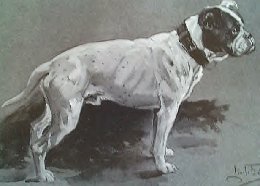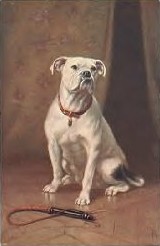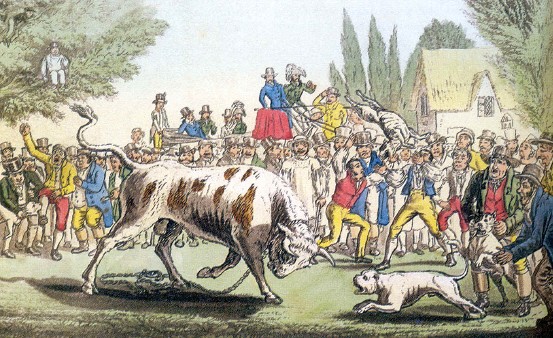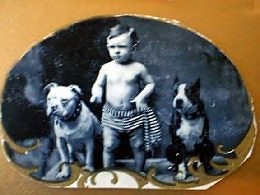
Let’s start out by stating that the history of the bulldog is quite unique. It dates back to the 13th century when butchers used to keep dogs that were bred to catch and hold wild cattle when the need arose. They were used when the herding dogs could not keep all of the cattle in line or when something needed catching for slaughter. These dogs had to show incredible courage and tenacity in successfully performing their function. They had to bite and hold. If they lost their grip, there was a good chance they would be gored or trampled. When catching a bull, they could be tossed into the air and crash to their death. They also caught boar. There are paintings from the 1500s that show men using bull-dogs to catch wild boar in Europe. All in all, the bull-dog was bred for a particular function (catching) that required courage, tenacity, and incredible tolerance for pain.
The Baited Bull Broke Loose In order to verify a dog’s ability to catch, would-be breeders would need to establish a way in which they could actually see the dog catch. Since the dog catches under difficult circumstances in real life, it is not always easy to have people around while the dog performs his duties. Therefore, breeding trials were formed to assess the dog’s catching capabilities. In Bull Baiting, a bull was tethered by means of chain or rope, usually around 15 feet in length. The catch-dog was brought toward the bull by his owner and then released. The dog had to catch the bull by the nose, cheek or ear. This activity was timed by a “glass” (an hour glass shaped instrument that had an elapsed time of around a minute). Bets were taken as to how fast the dog could secure its hold.
Tethered Bull When one reads any book about the bulldog, there are always gruesome stories of what owners used to do to their dogs to show courage. For purposes of this history, we will leave out such stories. We do not want to encourage this behavior in the 21st century. The Bite: There has been much discussion among bulldog enthusiasts regarding the bite of the bull-dog and why it is undershot. Some books state the reason for the undershot bite is to make sure the dog doesn’t lose his breath while biting and holding. The undershot structure allows the nose to be receded and tilted so as to collect oxygen while still holding. Other books state that it is important for the bull-dog to be undershot so that the big teeth don’t meet up when the dog sinks its bite into the animal for fear of tearing the flesh off where the bite occurs and thereby losing the grip. Our purpose in this history is not to debate which reason makes the most sense. The main point is that the bull-dog bite must be undershot!!! If the bite is not undershot (bottom teeth in front of top teeth) then the dog isn’t a bull-dog.  
Undershot Jaw
Fast forward to 1836: Bull baiting had just been outlawed. Dog fighting was outlawed as well. The bull-dog was used for both activities. History has it that the bull-dog was crossed with an English Terrier to create the Bull and Terrier which was eventually perfected in Staffordshire England to make the Staffordshire Terrier (Pitbull).
Various Bulldog Influences
L: Bulldog ~ R: Bull & Terrier How did the bull-dog find its way to America? This question has never gotten the complete and correct answer because, frankly, there are no official documents which show how the dog got here. What is certain is that this dog was not indigenous to America prior to the settlers coming from Europe. Either the British or Spanish….or both….brought bull-dogs to this country. It is important to note that the British sent their bull-dogs to Spain long before the 19th century. As a matter of fact, the Spanish let their bull-dogs get a bit bigger than the British. From this point forward, let’s make the change from bull-dog to bulldog. There is significance to this in that the singular word bulldog marks the modern dog of today. What is a White English Bulldog? The White English bulldog is the descendant of the bull-dogs mentioned above. How pure of a descendant is anyone’s guess. No one actually knows what if any dog has been crossed in the White English. We do know that they resemble most clearly the bull-dog prior to 1836. They also carry most of the temperament characteristics as well. However, the White English of today should not show the people aggression that the bull-dog reportedly had. We will never know what made the bull-dog mean, either hereditary or socially induced, but today’s White English should not have uncontrollable rage toward humans.
Litter from 1910
Bulldog of the1930's What we can clearly state is that the White English Bulldog is the precursor to the American Bulldog. It is common knowledge that back in the 1970s, John D Johnson and Alan Scott had White English which they used as their foundation stock for their brand of American Bulldog. Dogs such as Dick the Bruiser and Dixieman were White English. Two of the members of our board have been involved with the White English for many decades. One of the member’s families had been breeding White English since 1946. Jeff Clark has been breeding White English since 1964. These dogs were used mostly as multipurpose yard dogs. They kept vermin from the area and were willing hog hunting partners. Jeff Clark used his White English to catch hogs. One summer, Jeff and a friend caught 96 hogs. This was back in the day when there were no protection vests. Also, the hunting party usually consisted of only one, maybe two at the most, bay dog and a bulldog. In the 1980s,there were people in Louisiana who used their White English to catch hogs for their Wild Hog Preservation Society. The Working White English Bulldog that this organization registers are dogs which come from this background. There are other breeders whose White English are also in this registry. Dogs from Stover and Williamson are registered. There are still pockets in the deep south in America where White English bulldogs are living, untouched by American Bulldog blood. These dogs can be registered as White English if they meet the breed standard and a written history exists regarding their lineage.
|







